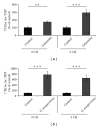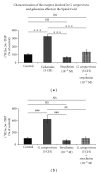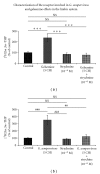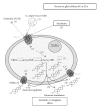Comparative Analysis of Gelsemine and Gelsemium sempervirens Activity on Neurosteroid Allopregnanolone Formation in the Spinal Cord and Limbic System
- PMID: 19628662
- PMCID: PMC3136435
- DOI: 10.1093/ecam/nep083
Comparative Analysis of Gelsemine and Gelsemium sempervirens Activity on Neurosteroid Allopregnanolone Formation in the Spinal Cord and Limbic System
Abstract
Centesimal dilutions (5, 9 and 15 cH) of Gelsemium sempervirens are claimed to be capable of exerting anxiolytic and analgesic effects. However, basic results supporting this assertion are rare, and the mechanism of action of G. sempervirens is completely unknown. To clarify the point, we performed a comparative analysis of the effects of dilutions 5, 9 and 15 cH of G. sempervirens or gelsemine (the major active principle of G. sempervirens) on allopregnanolone (3α,5α-THP) production in the rat limbic system (hippocampus and amygdala or H-A) and spinal cord (SC). Indeed, H-A and SC are two pivotal structures controlling, respectively, anxiety and pain that are also modulated by the neurosteroid 3α,5α-THP. At the dilution 5 cH, both G. sempervirens and gelsemine stimulated [(3)H]progesterone conversion into [(3)H]3α,5α-THP by H-A and SC slices, and the stimulatory effect was fully (100%) reproducible in all assays. The dilution 9 cH of G. sempervirens or gelsemine also stimulated 3α,5α-THP formation in H-A and SC but the reproducibility rate decreased to 75%. At 15 cH of G. sempervirens or gelsemine, no effect was observed on 3α,5α-THP neosynthesis in H-A and SC slices. The stimulatory action of G. sempervirens and gelsemine (5 cH) on 3α,5α-THP production was blocked by strychnine, the selective antagonist of glycine receptors. Altogether, these results, which constitute the first basic demonstration of cellular effects of G. sempervirens, also offer interesting possibilities for the improvement of G. sempervirens-based therapeutic strategies.
Figures








Similar articles
-
Regulation of neurosteroid allopregnanolone biosynthesis in the rat spinal cord by glycine and the alkaloidal analogs strychnine and gelsemine.Neuroscience. 2008 Apr 22;153(1):154-61. doi: 10.1016/j.neuroscience.2008.02.009. Epub 2008 Feb 19. Neuroscience. 2008. PMID: 18367344
-
Gelsemine and koumine, principal active ingredients of Gelsemium, exhibit mechanical antiallodynia via spinal glycine receptor activation-induced allopregnanolone biosynthesis.Biochem Pharmacol. 2019 Mar;161:136-148. doi: 10.1016/j.bcp.2019.01.014. Epub 2019 Jan 19. Biochem Pharmacol. 2019. PMID: 30668937
-
Gelsemium analgesia and the spinal glycine receptor/allopregnanolone pathway.Fitoterapia. 2015 Jan;100:35-43. doi: 10.1016/j.fitote.2014.11.002. Epub 2014 Nov 11. Fitoterapia. 2015. PMID: 25447163 Review.
-
Gelsemine, a principal alkaloid from Gelsemium sempervirens Ait., exhibits potent and specific antinociception in chronic pain by acting at spinal α3 glycine receptors.Pain. 2013 Nov;154(11):2452-2462. doi: 10.1016/j.pain.2013.07.027. Epub 2013 Jul 22. Pain. 2013. PMID: 23886522
-
Potential role of allopregnanolone for a safe and effective therapy of neuropathic pain.Prog Neurobiol. 2014 Feb;113:70-8. doi: 10.1016/j.pneurobio.2013.07.004. Epub 2013 Aug 12. Prog Neurobiol. 2014. PMID: 23948490 Review.
Cited by
-
Gelsemine and Gelsemium sempervirens L. Extracts in Animal Behavioral Test: Comments and Related Biases.Front Neurol. 2011 May 16;2:31. doi: 10.3389/fneur.2011.00031. eCollection 2011. Front Neurol. 2011. PMID: 21647210 Free PMC article. No abstract available.
-
Experimental neuropharmacology of Gelsemium sempervirens: Recent advances and debated issues.J Ayurveda Integr Med. 2018 Jan-Mar;9(1):69-74. doi: 10.1016/j.jaim.2017.01.010. Epub 2018 Feb 7. J Ayurveda Integr Med. 2018. PMID: 29428604 Free PMC article.
-
The active alkaloids of Gelsemium elegans Benth. are potent anxiolytics.Psychopharmacology (Berl). 2013 Feb;225(4):839-51. doi: 10.1007/s00213-012-2867-x. Epub 2012 Oct 5. Psychopharmacology (Berl). 2013. PMID: 23052566
-
Koumine exhibits anxiolytic properties without inducing adverse neurological effects on functional observation battery, open-field and Vogel conflict tests in rodents.J Nat Med. 2017 Apr;71(2):397-408. doi: 10.1007/s11418-017-1070-0. Epub 2017 Jan 19. J Nat Med. 2017. PMID: 28105568
-
Toxic Effects of Koumine on the Early-Life Development Stage of Zebrafish.Toxics. 2023 Oct 12;11(10):853. doi: 10.3390/toxics11100853. Toxics. 2023. PMID: 37888703 Free PMC article.
References
-
- Baulieu EE, Robel P, Schumacher M. Contemporary Endocrinology. Totowa, NJ, USA: Humana Press; 1999.
-
- Mellon SH, Griffin LD. Neurosteroids: biochemistry and clinical significance. Trends in Endocrinology and Metabolism. 2002;13(1):35–43. - PubMed
-
- Mensah-Nyagan AG, Do-Rego J-L, Beaujean D, Luu-The V, Pelletier G, Vaudry H. Neurosteroids: expression of steroidogenic enzymes and regulation of steroid biosynthesis in the central nervous system. Pharmacological Reviews. 1999;51(1):63–81. - PubMed
-
- Patte-Mensah C, Mensah-Nyagan AG. Peripheral neuropathy and neurosteroid formation in the central nervous system. Brain Research Reviews. 2008;57(2):454–459. - PubMed
-
- Dubrovsky B. Neurosteroids, neuroactive steroids, and symptoms of affective disorders. Pharmacology Biochemistry and Behavior. 2006;84(4):644–655. - PubMed
LinkOut - more resources
Full Text Sources
Other Literature Sources

